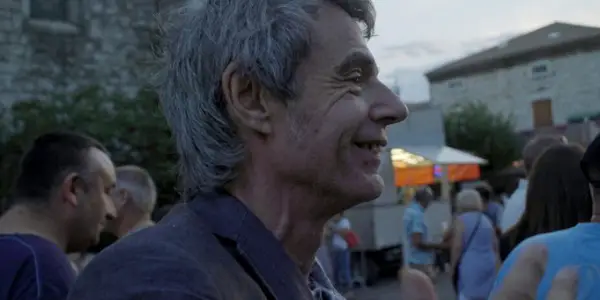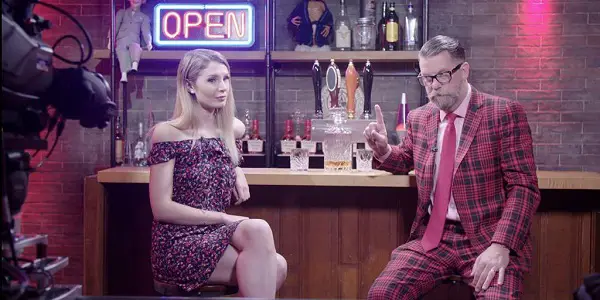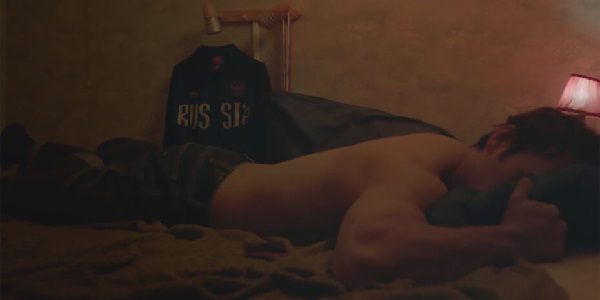IDFA Part 1: THE GROCER’S SON…, WHITE NOISE, SILENT VOICE, BULLETPROOF

Musanna Ahmed is a freelance film critic writing for Film…
2020’s International Documentary Film Festival of Amsterdam (known as IDFA) had one of the richest programmes I’ve seen for a virtual festival. There were over 170 films screened across feature, mid-length and short film categories. Many filmmakers got the opportunity to premiere their latest work for the first time and the festival team ensured there was an ample section of festival highlights. IDFA has long been at the top of the list for best documentary film festivals in the world – the fact that the team still went all out for a digital edition is a testament to their passion for championing the art and creativity of non-fiction filmmaking. I’m grateful to have attended the virtual IDFA and have written a series of reviews for the films I saw. Here is Part 1 of 3, detailing my thoughts on The Grocer’s Son, the Mayor, the Village and the World (that’s one title!), White Noise, Silent Voice, and Bulletproof.
The Grocer’s Son, The Mayor, the Village and the World (Claire Simon)
Claire Simon, one of our most underappreciated living filmmakers, returns by turning her trusted lens towards the small French village of Lussas as it undergoes a transformation into a hub for non-fiction cinema. We witness the launch of a new streaming service – Tënk, purporting to be the first VOD platform exclusively dedicated to documentary – and the construction of a permanent theatre that’ll serve as a cinema exhibition space. It only makes sense that Simon was curious enough to make a documentary out of the whole scenario.
The ambitiously titled The Grocer’s Son, The Mayor, The Village and the World opens on a regular day in the quaint green village, with images of the tranquil fields, quiet roads, and lone church. We follow a young boy selling raffle tickets as he walks into an office for film workers with no idea of what they do. Their work – building the aforementioned streaming service – is a surprise to us as much as it is to the kid, considering that the brief images of Lussas indicate zero possibility of a Silicon Valley-esque endeavor. With her masterful observational style, Simon records the contrast between modernity and tradition in Lussas, as a group of passionate film lovers attempt to create cutting-edge tech against a classical milieu.

There are fascinating dichotomies throughout the entire film, such as the film events’ successful attraction of international customers yet appealing to few local audiences. The strong sense of agriculture permeates life in the village; some team members are full-time doc lovers and part-time farmers. The dual concept of erecting an entire home to screen documentary films and making a dedicated streaming platform isn’t trusted by the economical gatekeepers – these ideas are only realised thanks to a cost reduction of 70% for the building and a special offer of one euro for the first month of the streaming service.
Simon hasn’t made this film to promote Tënk or the construction project. But her keen eye for detail touched me as a doc fan (hence my presence at the virtual IDFA) and I left the film desperately wanting to visit the newly coined Lussas Documentary Village. As an outstanding work of cinéma vérité that captures human dynamics within an institutional context, The Grocer’s Son… feels like the sort of film that would seize Frederick Wiseman’s heart.
White Noise (Daniel Lombroso)
I’ve seen a good number of films over the past few years about how fascism can easily be empowered – Look Who’s Back, The Brink, etc – but no matter how many I see, I can never become numb to what I’m seeing. It’s because no matter how understated or sensationalised they may be, they contain an absolute truth that we can understand just by looking around, examining the current state of the world, and seeing how far-right politics are alive and well. White Noise is unnerving viewing but surprisingly offers comfort by revealing the diminishing influence of some dangerous individuals.
Filmmaker Daniel Lombroso, working with news outlet The Atlantic, where he worked for years as a staff producer, embedded himself for four years in the lives of three famous alt-right figures. Namely, white nationalist Youtuber and Great Replacement conspiracy promoter Lauren Southern, anti-feminist InfoWars host Mark Cernovich, and literal neo-Nazi Richard Spencer. I never want to spend any more time in the virtual company of these three individuals. But for as long as I did, Lombroso made it worthwhile, through his keen eye for detail and ability to broaden our understanding of the alt-right public image.
By observing these subjects in their domesticity, the filmmaker invites a contrast between their attempts to stay publicly relevant and inane private lives. They depend so much on their online profiles – which are essentially smear campaigns against leftists and promotion of political incorrectness – spending a lot of time behind their webcams. So much so that there’s little to extract from their private lives. Spencer likes to watch the opera – his original dream was to be a stage director – which explains his penchant for theatricality. Cernovich has a wife and child who seem to be shielded from the controversies surrounding the man of the house, all enjoying a quiet life together. And that’s precisely what makes it all scary – in this charged cultural climate, any seemingly ordinary person can win support by simply championing harmful rhetoric.

The most interesting “off-camera” moment with Southern occurs after she meets with infamous Proud Boys founder Gavin McInnes and finds herself repeatedly accosted by him in a sexual context. Lombroso captures the awkward phone call after their interview and, later, she speaks to the filmmaker about realising how, as a woman, only she can look out for herself in this world, to which the filmmaker correctly questions if she initially helped establish the anti-feminist mentality that has empowered people like McInnes.
As much as the director humanises the three subjects for the intent of customary documentary filmmaking, it is impossible to sympathise with them in their low moments, knowing how much bad influence they have had in the world. Consequently, the film resonates better as an outlet of schadenfreude, like Lauren Greenfield’s The Queen of Versailles. It is especially gleeful to watch Cernovich and Spencer indirectly take swipes at each other, showing how the alt-right is as segmented as they believe the liberal world to be.
Though his ability to encourage good interviews out of his subjects is sound, where Lombroso shines is in his visual storytelling. The editing is slick, fluidly navigating between each of the three perspectives to establish a collective arc of rising to power and now flirting with irrelevance. His film has many cringe-inducing moments that you can’t turn away from, like the trainwreck that was Spencer’s appearance at Michigan State Uni, and he strongly assembles both his own and third-party footage to great effect.
Silent Voice (Reka Valerik)
The Belgian documentary Silent Voice centres on Khavaj, a gay Chechen mixed martial arts fighter who goes into hiding after his sexual identity is compromised. As an MMA fan, I’ve read many stories by investigative journalist Karim Zidan, who has uncovered how many high-profile fighters around the world are linked in some way to Chechen dictator Ramzan Kadyrov. It’s essentially a rite of passage for athletes from the Caucasus to befriend the controversial leader.

Silent Voice offers an altogether different perspective, a powerful and unique one. In this story, the Kadyrov regime puts the athlete in danger, forcing him to distance himself from his homeland. Twisting the common narrative of seeking alignment, here’s the raw experience of a fighter suffering from psychogenic aphonia whilst working with an organisation who helps gay people who have fled their countries.
Reka Valerik’s film is part direct cinema, part impressionistic, and completely moving. It’s a poignant observation of Khavaj as he waits for refugee status in Belgium, his situation exacerbated by his inability to speak. Valerik focuses on corporeal details to vividly build an understanding of what Khavaj is willing to put on the line to represent his country as an athlete. The tearful voice notes from his mother, throwing in all the words he doesn’t want to hear – impure, dishonor, hatred – overwhelm the film with melancholy, which is accentuated by the pain of being stuck in Euro-bureaucratic limbo. Ultimately, though, we are left with hope for Khavaj.
Bulletproof (Todd Chandler)
Bulletproof is a somber documentary about the sick, undeniable reality that the US is donating too many resources – time, money and people – to making teachers and students practise how to protect themselves during a school shooting rather than taking any action to prevent the root cause of such tragedies.
We watch as classrooms devote time to drills on calming themselves and taking optimal escape routes during a live shooting scenario. An interesting point is made by one student who says that the repeated drills are essentially as traumatic as the real thing, whilst another student suggests that media coverage amplifies the fear in every student’s heart. It’s clear that teachers and students are well equipped after all the rehearsals but nothing can stop an unassuming kid from obtaining a weapon in the first place.

What’s more frustrating is witnessing the shameful attempt to assign a boogeyman that isn’t the most obvious one – in a school board meeting, one adult puts the blame on SSRI’s for triggering violent and suicidal tendencies. The students shake their heads in disbelief. Just like I shook my head watching footage of a market where staff members can buy walls, tracking systems, and other sorts of tech that should not have to exist. Wonder Hoodies founder Vy Tran is interviewed for the film, speaking about how she came to manufacturing bulletproof hoodies as a vigilante response to keeping people safe. However, when such inventors succeed, competition is created, and it all turns into a lucrative business. Someone might end up on the Forbes list for their services to stop kids from dying because Congress won’t do anything about it.
Todd Chandler takes an appropriately measured approach to filming: primarily utilising a fixed camera, with no interference to transactions, communications, and rehearsals, simply highlighting the stark day-to-day reality of the American school system. Occasionally, though, the filmmaker gets up in an almost Malickian-level of obsession with abstract images. Bulletproof is a powerful indictment on inaction around a serious American crisis, one that especially hits close to home right now with the coronavirus response.
Stay tuned for Part 2 of Film Inquiry’s IDFA coverage.
Does content like this matter to you?
Become a Member and support film journalism. Unlock access to all of Film Inquiry`s great articles. Join a community of like-minded readers who are passionate about cinema - get access to our private members Network, give back to independent filmmakers, and more.
Musanna Ahmed is a freelance film critic writing for Film Inquiry, The Movie Waffler and The Upcoming. His taste in film knows no boundaries.













